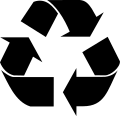
| Cotton |
|---|
 |
| History |
| Terminology |
| Types |
| Production |
| Fabric |
| Part of a series on |
| Clothing and the environment |
|---|
| |
| Environmental impact of fashion |
Cotton recycling is the process of converting cotton fabric into fibers that can be reused into other textile products. [1]
Contents
- Raw material
- Composition of Starting Material
- Collection of Materials
- Sorting of Materials
- Quality Assessment
- Process
- Mechanical Recycling
- Chemical Recycling
- Potential Impacts
- Assessment Standard
- Recycled vs. Organic Cotton Fibers
- Concerns
- Limitations
- Technical Difficulties
- Social Difficulties
- Brand-led Recycling
- Future Policies and Laws
- See also
- References
- External links
- Further reading
Recycled cotton is primarily made from pre-consumer cotton which is excess textile waste from clothing production. [1] It is less commonly made from post-consumer cotton which is discarded textile waste from consumers such as second hand clothing. [1] The recycling process includes assessing the quality of cotton fibers through systematics collection, manually sorting the materials, and undergoing a mechanical or chemical process to break down the textile fabric into reusable fibers. [2] In the mechanical process, fabrics are torn into individual fibers through a machine, and in the chemical process, the fabrics's chemical properties are broken down through chemical reaction processes such as Lyocell process and dissolution in ionic liquids. [3] [4] The mechanical process is the primary way to recycle textiles because the chemical process is not commercially used. [5]
Recycled cotton is less durable than virgin cotton due to the shorter length of recycled cotton fibers which result from mechanical recycling. As a result, recycled cotton requires the addition of additional materials such as polyester to improve durability. [3] Therefore, recycled cotton is often used in products that do not require high-quality cotton fibers such as casual clothing and home building materials. [3] [6]
Harvesting raw cotton is a resource intensive process that uses a lot of water, energy, and chemicals. [7] Cotton recycling mitigates wastage and can be a more sustainable alternative to disposal because products can be made out of existing textiles instead of raw materials, therefore, reducing the resources required to harvest raw cotton. [7] However, there are costs associated with cotton recycling, such as the risk of problem shifting and the impact of transporting collected materials which could exceed its intended benefits. [8] Researchers and governments are looking for new technologies and industrial management solutions to improve the social impact of the collection processes for recycled cotton. [9]
